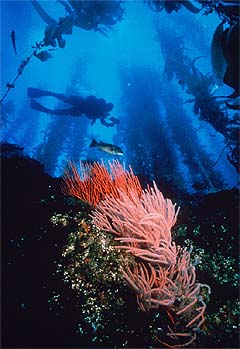Resource Issues: Water Quality
Nonpoint Source Pollution
Overview of the issue
Coastal watershedsimmediately adjacent to the Sanctuary cover over 7000 square miles of land with a mix of land uses including major urban areas, rural communities, agricultural land, and pockets of industrial areas. As rainfall or irrigation water in these watersheds moves downstream, it picks up a variety of contaminants. Offshore areas of the Sanctuary are in relatively good condition, but nearshore coastal areas, harbors, lagoons, estuaries and tributaries show a number of problems including elevated levels of coliform bacteria, detergents, oils, nitrates, sediments, and persistent pesticides such as DDT and toxaphene. These contaminants can have a variety of biological impacts including bioaccumulation, reduced recruitment of anadramous species, algal blooms, transfer of human pathogens and interference with recreational uses of the sanctuary due to beach closures.
 How is the Sanctuary involved?
How is the Sanctuary involved?
The Sanctuary's Water Quality Protection Programcommittee has developed multistakeholder plans for urban runoff, marinas and boating, agriculture and rural lands, and water quality monitoring. Implementation of all of these plans has begun with a variety of partners, and updates can be found in the individual sections. Recent problems such as recurring beach closures, which are in part due to nonpoint sources of coliform pollution, have not yet been adequately addressed in the urban runoff and water quality monitoring efforts.
Point Sources of Pollution
Overview of the issue
Point sources of pollution are those in which a single discharge point is evident, and they include sewage spills and discharges, desalination plants, and industrial discharges such as power plants. Sewage spills have become more frequent in recent years, in part due to cracks and clogging of aging pipelines beneath many of the region's cities and small communities. These spills, along with nonpoint sources of coliform, have contributed to more frequent beach closures that reduce recreational use. Pathogens from sewage have also been implicated in sea otter diseases and mortality patterns.
In addition, there are currently 15 desalination plants that are existing or in some stage of planning within Sanctuary region, with an increasing trend towards the development of small independent plants for private developments. Discharges from these plants have potential impacts due to elevated salinity and metal levels, toxic contaminants associated with cleaning and maintenance, and construction impacts from pipelines. Point sources of pollution also include power plant discharges which discharge large volumes of heated water generated by the plant's cooling processes.
How is the Sanctuary involved?
The Sanctuary reviews point source discharges on a case-by-case basis to recommend measures to minimize impacts and ensure adequate monitoring. These discharges require Sanctuary authorization of permits issued by the Regional Water Quality Control Board. The Sanctuary is also involved in developing regional solutions to the issues of beach closures and desalination, as detailed above.
